Conscription in WW1 by Abbie Goodwin
“To enable our country to organise more effectively its military resources in the present great struggle for the cause of civilisation, I have, acting on the advice of my Ministers, deemed it necessary to enrol every able-bodied man between the ages of eighteen and forty-one.” King George V, statement issued on 25th May 1916
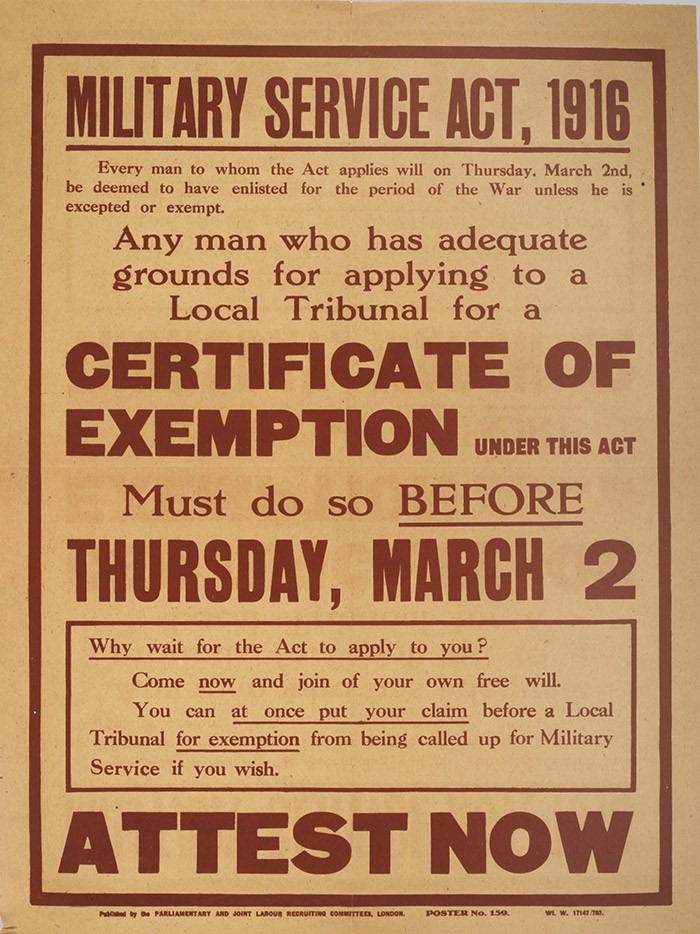
Within a year of Britain declaring war on Germany, it became clear that it was not possible to continue fighting through relying on volunteers alone. Since the outbreak of war in August 1914, over 1 million men had willingly enlisted to join the military – however, the heavy casualties that the British Army had suffered on the Western Front meant that army numbers were falling thick and fast. Furthermore, by mid-1915 the amount of men lining up to volunteer was dwindling meaning that Britain was facing a man-power crisis. To put it simply – Britain did not have enough soldiers to win a war.
However, conscription was very controversial. Essentially, it meant that the British government was intruding itself into individual citizen’s lives and forcing them to fight for their King and country. Before introducing it, the government tried various tactics in order to persuade men to enlist:
Propaganda posters
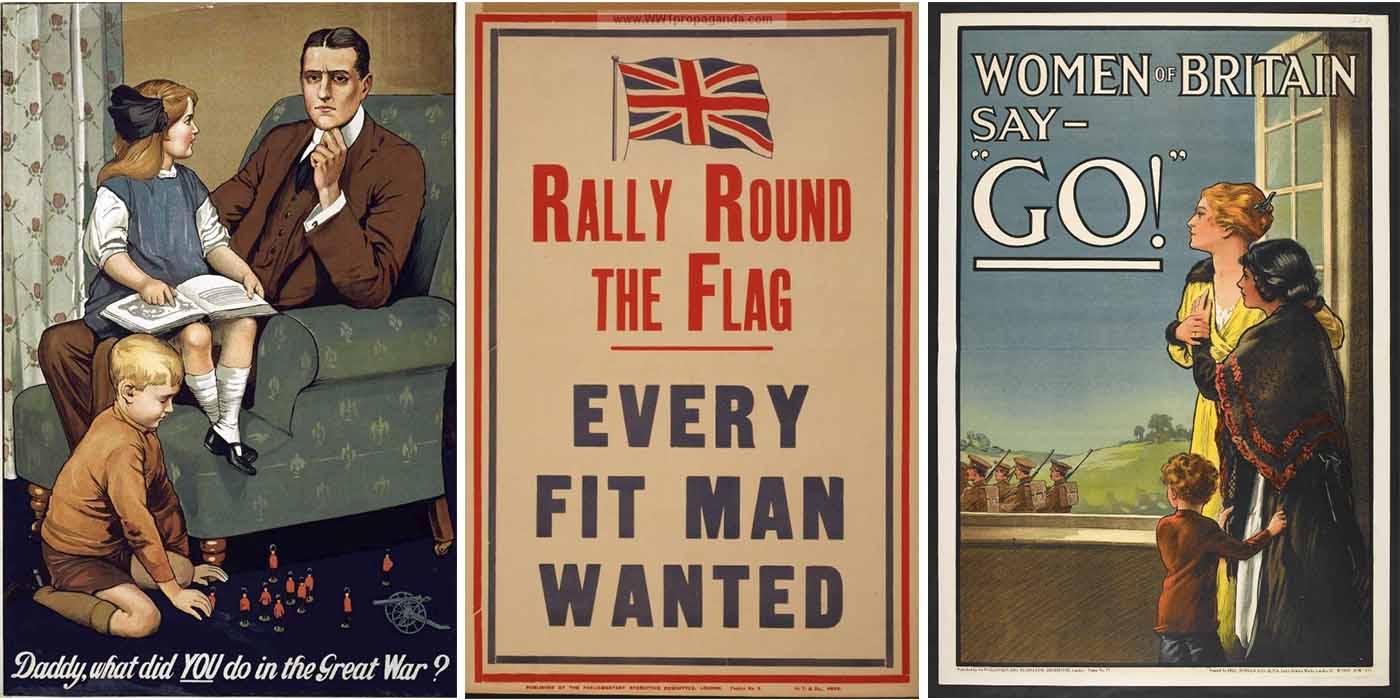
Propaganda posters, such as the ones above, were created to not only persuade men that they should fight in the war – but that it was their moral duty to themselves, their families, their King and their country. Many posters used vices such as emotional blackmail, the infamous “Daddy, what did YOU do in the Great War” used children to shame their elders about their role in the war. Others played on ideas of masculinity, the future promise of glory and most importantly patriotisms – loyalty to Britain.
Lord Kitchener’s Campaign
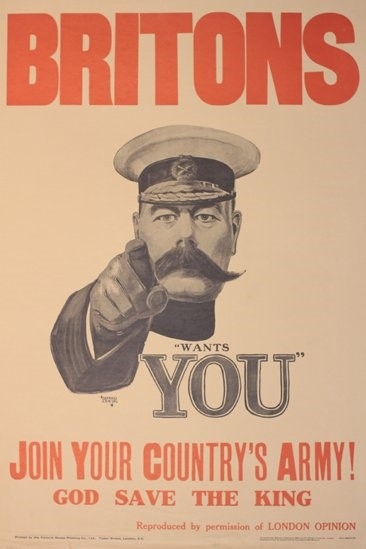
Pals Battalions
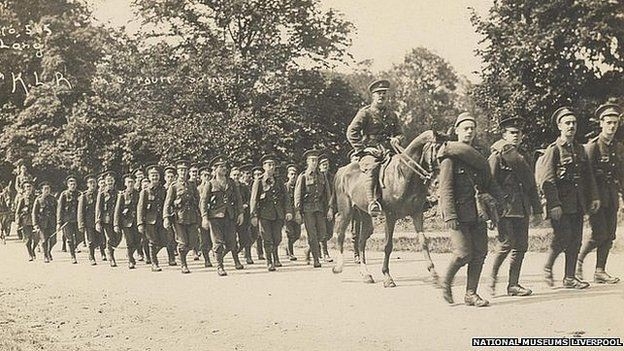
Another tactic employed by the government was the ‘Pals Battalions’ – the idea that men would be more willing to join up if they could serve with people they already knew. Lord Derby was the first to test the idea when he announced that he would attempt to raise a battalion in Liverpool comprised solely of local men. Recruitment began in St Georges Hall on the 31st August and within days, enough men had enlisted from the city to form four battalions. After the success of Liverpool, more cities began to create similar Pals Battalions – filled with civic and local pride, soon cities were competing with each other to see who could recruit the most men.
However, the voluntary schemes proved not to be enough to provide Britain with a force large enough to fight the German military machine and despite the opposition from many in parliament, in January 1916 The Military Service Act was enforced. This specified that single men between the ages of 18 and 41 were liable to be called-up for military service unless they were widowed with children or ministers of religion. Conscription would start on the 2nd March 1916.
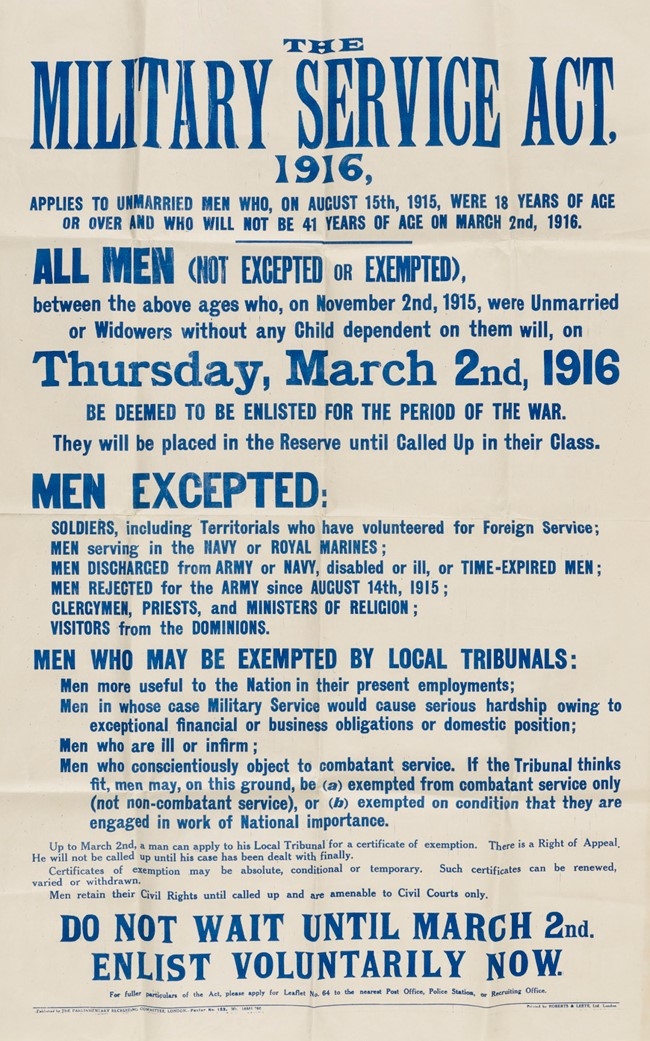
The act went through various changes as war efforts demanded more men, in May 1916 it was extended to married men and by 1918 the age was raised to 51.
Men who believed themselves exempt from military service could appeal to local tribunals on grounds of poor health, employment in key occupations, family circumstances and conscientious objection to the war. These tribunals, composed largely of local representatives, could either insist the individual concerned enlist, defer their entry or grant their appeal and exempt him. It has been suggested that these tribunals were especially hostile to those claiming exemption on the grounds of conscience and many conscientious objectors were sent to prison under harsh conditions.
Despite the unpopularity of conscription and the many demonstrations against it, most prominently in April 1916 when 200,000 attended an anti-conscription demonstration at Trafalgar Square, it continued until the end of the war in 1918 by which a total of 2.5 million men had been conscripted. Conscription in the First World War represented one of the most significant indications of the impact of ‘total war’ upon the British state, its institutions and its communities – it also set a precedent for the war that would follow just 21 years later.
‘C is for Conscription’ – short video on the effects on conscription on a mother and her family
http://www.bbc.co.uk/education/clips/ztmwq6f
By Abbie Goodwin
Theatre and Community Intern at the Everyman & Playhouse and final year English and Drama student at Liverpool John Moores University
Websites Used:
http://spartacus-educational.com/FWWconscription.htm
http://www.parliament.uk/about/living-heritage/transformingsociety/priva...
https://www.thegazette.co.uk/all-notices/content/100501
http://www.iwm.org.uk/learning/resources/how-did-britain-increase-and-ma...
http://ww1facts.net/people/conscription/
http://www.bbc.co.uk/timelines/zqbhn39
https://www.bl.uk/world-war-one/articles/patriotism-and-nationalism
Images used:
Military service act – https://www.thegazette.co.uk/all-notices/content/100501
Daddy what did you do in the Great War? - https://www.bl.uk/world-war-one/articles/patriotism-and-nationalism
Women of Britain say “Go!” - https://www.bl.uk/world-war-one/articles/patriotism-and-nationalism
Rally round the flag - http://www.ww1propaganda.com/world-war-1-posters/british-ww1-propaganda-...
Britons Want You - http://www.bbc.co.uk/schools/0/ww1/25332968
Liverpool Pals Battalion http://www.bbc.co.uk/news/uk-england-28344715